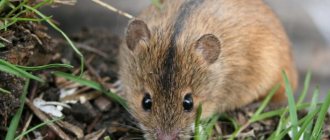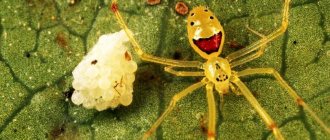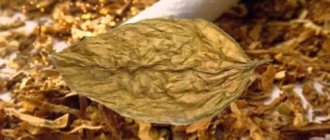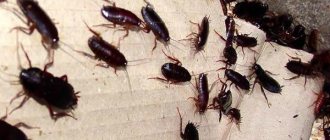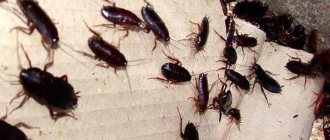Appearance
The genus of shrews includes about 130 species, which differ from each other not only in habitat, but also in size. These are small animals, the distinctive features of which are a long tail and an elongated muzzle.
Body size can range from 5 to 10 cm, depending on the variety. Tail - from 3.5 to 7.5 cm. Weight - from 2.5 to 15 grams.
The entire body is covered with fine, dark-colored fur, brownish-gray in most species. The abdomen is light. The tail is covered with thick short fur.
The tops of the teeth are brownish-red in color - this is how the animal got its name. However, the older the shrew, the more its teeth wear down, and this color may gradually disappear. Dental formula of a shrew: incisors 3/2, canines 1/0, premolars 3/1, molars 3/3.
The ears are small, almost do not protrude above the surface of the coat. The eyes are black, but due to the predominantly underground lifestyle, vision is poor and poorly developed.
As a result, the animal searches for food using a powerful sense of smell or echolocation.
Shrews are one of the oldest branches of mammals, and their teeth have a clear division into canines, incisors, and molars.
REFERENCE! All animals of this species have a strong smell of musk, which is why many predators, having caught a shrew, refuse to eat it and throw it away.
The animal's prints are shallow, small, and usually arranged in pairs. When there is no hard crust on the snow, a clearly visible imprint of the tail remains.
Characteristic
The tiny shrew is one of the smallest insectivorous creatures in Russia and Europe. The size of an adult individual including the tail is 6-7 cm, and the weight does not exceed five grams. It would be more correct to describe the tiny shrew with the silky fur of a soft coffee color on the back, which turns into light fluff on the belly. The tail, which is slightly more than half the length of the shrew's body, is also two-colored. The paws are not covered with fur.
In summer, the color of the animal fades slightly, and in winter it becomes richer. The animal's ears are small, but hearing is very well developed, as is touch and sense of smell. The elongated head ends in a proboscis nose with bristling vibrissae (long whiskers).
Shrews do not live more than a year and a half, and approximately a fifth of this short life is spent during their breeding season. Unlike most animals, the female's gestation period is not strictly fixed. The cubs will be born healthy in both 18 and 28 days. The average number of babies per litter is about five, but sometimes there are 8. During her life, an adult female gives birth to from 1 to two litters.
Distribution and reproduction
Shrews are common in many countries. They are most often found in North America, northern Asia, and Europe.
This is the most common type of shrew that can live in any conditions - forests, forest-steppes, tundra, sometimes even in the floodplains of steppe rivers and meadows. Does not settle in wetlands.
About 15 species live on the territory of Russia, which are quite difficult to distinguish from each other (read about where the shrew lives and what it eats here). The main features here are the details of the body structure and genitals.
They live everywhere, from Moscow to the Primorsky Territory and Sakhalin.
In the taiga zone, the normal number of animals is in the range of 200-600 individuals per hectare, in the tundra - 3-5 times less.
The average life expectancy of a shrew is 1-1.5 years. It begins to reproduce in the second year, immediately after the end of the winter period.
It creates nests in the form of a ball from plant stems, which it places under stumps and tree roots. Pregnancy lasts on average 20 days.
Young individuals leave the nest on the 20th day after birth. During the season, the shrew leaves 3 litters, and in the first there are 8-10 cubs, and in the last - only 3-4. The second litter appears after the grown individuals from the first leave the nest.
Shrew habitat
Most shrews are found in Northern and Western Europe, including the northern and northwestern regions of Russia. These animals live in a variety of places, but prefer shade and moist soil. They live in parks, forests, and sometimes in swamps; The shrew usually avoids open places.
Like mice, shrews are often found in residential buildings in rural areas, where they especially frequent in the fall and winter. At the same time, they tolerate quite harsh conditions and are able to survive the winter without falling into a long hibernation. It is curious that in particularly severe winters, shrews live in abundant snowdrifts, while in the open they can die.
Lifestyle
Shrews are active throughout the year , and they endure winter without plunging into a long hibernation. During the day, they carry out most of their activity at dusk and at night.
Despite the fact that the animal is part of the genus shrews , it does not build holes on its own, but uses ready-made labyrinths of underground animals, moles, natural cracks and holes in the ground.
They can trample passages under the forest floor and in thick snow (passage diameter 2 cm).
In winter, they practically do not rise from under the snow, but if it is impossible to dig out insect larvae from the frozen soil, they move along the surface in search of plant seeds.
REFERENCE! If there is no food, it dies within a few hours.
The shrew has a very high metabolic rate - it eats up to 150% of its body weight, 15 grams of animal food or 20 grams of fish per day.
The frequency of food intake depends on the size - the smaller the animal, the more often it needs to eat. For example, a tiny shrew must eat 78 times a day!
During winter, the amount of seeds and plant foods in the diet increases. There are known cases of creating reserves for this time from earthworms.
Also, for a successful winter, there are innate protective processes - in the autumn there is a serious decrease in body weight and its volume, which includes all internal organs, including the brain.
In the spring, before the onset of the breeding season, the body returns to normal size.
Behavior
The common shrew leads a solitary lifestyle. The appearance of a food competitor in her home area threatens her with starvation, so she strives to drive him out of her territory at any cost.
When she sees a fellow tribesman, she makes terrifying sounds and demonstrates her determination to rush to the attack. If the uninvited guest does not retreat, the little animal boldly rushes into battle. Fighting often leads to serious injuries to duelists.
The home range of a male or female with offspring occupies an area of 300 to 600 square meters.
Activity occurs throughout the day, with the exception of short rest breaks. When searching for food, the wood shrew relies mainly on hearing and smell; vision plays a secondary role.
She does little to construct underground communications, but prefers to find abandoned burrows of small rodents or uses natural voids formed in the soil. She builds compacted tunnels in the thickness of fallen leaves, through which she runs very quickly.
Active activity does not stop even in severe frosts. The common shrew spends the winter under snow cover, making numerous tunnels under it. In the absence of snow and ice, it climbs to the surface of the soil and looks for plant seeds that have fallen to the ground.
In winter, wood shrews decrease in size, significantly losing weight. Not only its insides become smaller, but even the bones of the skull, which causes a reduction in brain volume.
Despite its modest physical characteristics, it can desperately defend itself when all escape routes are cut off. In addition to bites, the animal uses chemical weapons for self-defense. On the sides of the body and near the base of the tail there are fragrant glands that secrete a secretion with an unpleasant odor that repels many predators.
The main natural enemies are tawny owls (Strix aluco), various snakes and lizards. Stoats (Mustela erminea), foxes (Vulpes) and domestic cats hunt shrews only in a state of prolonged fasting.
Photo
See below: shrew photo
Ways to deal with shrews
Digging through many-meter-long tunnels in search of food, the shrew spoils not only vegetable plants, but also lawns and front gardens. This cannot be allowed.
- Careful and deep digging of the site.
- Pour crushed (not finely) eggshells into the hole.
- Low-growing marigolds and legumes planted in rows are effective. Additionally, garlic or onions are planted around the perimeter of the site - this is not something that shrews eat, their smell is good at “daring off” the animals.
- Using traps with baits that are used for mice.
- They install a repeller, which is a tin turntable that constantly creates noise. Shrews really do not like such “noise performances” and move away from such places. Similar repellers have appeared on sale, only electric ones.
- A simpler repeller that creates noise and rumble - cut-off tin cans or plastic bottles are attached to driven pegs 1 m high.
- A method that allows you to block access to the site for small pests: dig sheets of iron or slate around the perimeter of the site to a depth of 1.5 meters. The shrew doesn’t burrow that deep, so it certainly won’t be able to overcome such an obstacle.
- Tornado ultrasonic devices have proven themselves to be excellent; they are absolutely safe; their operating principle is low-frequency vibrations that are not tolerated by the shrew family.
Video
Benefits and harms
Shrews are predominantly insectivorous animals, and therefore usually do not damage agricultural crops.
in winter they can sneak into houses, barns, and sheds to search for food, both plant food (seeds) and the larvae of sleeping insects.
Some farmers believe that the shrew is the reason for the large number of minks appearing on lawns or beds. But this animal cannot dig them on its own, since its paws are not designed for digging!
At the same time, thanks to the constant search for food, the animal destroys a huge number of insect pests, including those overwintering in the litter and in the top layer of soil.
Its main diet consists of worms, larvae, spiders, woodlice, including such pests as slugs, May beetles, mole crickets, leaf beetles, weevils, moth caterpillars and cutworms.
In case of severe hunger, the shrew attacks ground beetles or small mice.
IMPORTANT! If the desire to get rid of an animal on the site still exceeds the benefit it can bring, it is best to use non-fatal methods - for example, ultrasonic repellers.
For large agricultural areas, the shrew brings more benefit than harm. But small gardens can suffer from this animal. We have prepared an article on how to deal with shrews in the garden and summer cottage.
Feeding features of shrews
Shrews are carnivorous mammals. They spend almost all their time searching for food. They cannot live even three hours without food. This is due to intense metabolism and rapid digestion of food.
The shrew's diet includes earthworms, insect larvae and pupae, butterflies, and dragonflies. In addition, it also hunts animals such as mouse-like rodents and frogs. In winter, the food is monotonous, since under the snow in the unfrozen soil layer the shrew can only find wintering insects. Once in cellars and pantries, the shrew never touches food supplies; it only looks for insects.
Plant food can serve as a supplement to the shrew's main diet, especially in winter, for example, seeds of spruce and pine cones, linden nuts.
